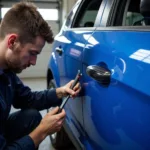Getting a scratch on your car bumper is an unfortunate reality for many car owners. Whether it’s a minor scrape from a parking mishap or a deeper gash from a more serious incident, bumper scratches can be unsightly and impact the overall appearance of your vehicle. The good news is that car bumper scratches repair doesn’t always have to break the bank. This comprehensive guide will walk you through everything you need to know about fixing those pesky scratches and restoring your car’s exterior to its former glory.
Understanding the Extent of the Damage
Before diving into repair options, it’s crucial to assess the severity of the scratch on your car bumper. This will determine the appropriate course of action and help you choose the right repair method.
- Clear Coat Scratches: These are the most superficial scratches, only affecting the outermost layer of your car’s paint. You can often buff these out with a polishing compound.
- Paint Scratches: These go deeper than clear coat scratches, exposing the primer or bare metal underneath. Repairing paint scratches usually involves touch-up paint and clear coat application.
- Deep Scratches: These penetrate through the paint, primer, and sometimes even the bumper itself. Deep scratches require more extensive repair work, potentially involving filling, sanding, and repainting.
DIY Car Bumper Scratch Repair vs. Professional Repair
Once you’ve assessed the damage, you can decide whether to tackle the repair yourself or seek professional help.
DIY Repair: For minor scratches and those comfortable with basic car maintenance, DIY repair can be a cost-effective option. Numerous car bumper repair kits are available, offering a range of solutions for different scratch types.
Professional Repair: Deeper scratches, extensive damage, or those lacking the time or confidence for a DIY approach are best left to the experts. Professional auto body shops have the experience, tools, and expertise to ensure a seamless and long-lasting repair.
DIY Car Bumper Scratch Repair: A Step-by-Step Guide
For minor to moderate scratches, here’s a general guide on how to repair scratches on car bumper yourself:
-
Clean the Area: Thoroughly wash and dry the scratched area to remove dirt, debris, and wax.
-
Sand the Scratch: For deeper scratches, use fine-grit sandpaper (2000-grit) to smooth the edges and create a uniform surface for the repair compound to adhere to.
-
Apply Repair Compound: Depending on the scratch’s severity, use a rubbing compound, touch-up paint, or a specialized bumper repair kit. Follow the manufacturer’s instructions carefully.
-
Dry and Sand (if necessary): Allow the repair compound or touch-up paint to dry completely. If necessary, lightly sand the area again to blend it with the surrounding paint.
-
Polish and Wax: After achieving a smooth surface, use a polishing compound to restore the shine and protect the repaired area. Finally, apply a coat of wax to the entire bumper for added protection and a uniform finish.
How to Repair Scratches on Car Plastic Bumper
Modern cars often feature plastic bumpers. If you’re wondering, “How to repair scratches on car plastic bumper?”, the process is similar to repairing metal bumpers but with a few key differences.
-
Identify the Plastic Type: Determine if your bumper is made from thermoset or thermoplastic. This information is usually found in your car’s owner’s manual.
-
Choose the Right Repair Products: Different products are designed for different plastic types. Ensure you select a repair kit or touch-up paint compatible with your bumper’s material.
-
Follow a Similar Repair Process: Cleaning, sanding (if needed), applying the repair compound, drying, and polishing remain crucial steps for [how to repair scratches on car plastic bumper](https://carrepairon.com/how to-repair-scratches-on-car-plastic-bumper/).
How to Repair Scratches on Black Plastic Car Bumper
Black plastic bumpers are particularly susceptible to showing scratches. For those wondering how to repair scratches on black plastic car bumper, specialized black plastic bumper repair products are available. These products often come in a dye or paint form and are designed to restore the color and shine of faded or scratched black plastic.
Tips for Preventing Bumper Scratches
Prevention is always better than cure. Here are some tips to minimize the risk of future bumper scratches:
- Practice Safe Parking: Park away from shopping carts, other vehicles, and areas with high foot traffic.
- Be Mindful of Height: Be aware of your car’s clearance when parking near curbs, ramps, or uneven surfaces.
- Consider Bumper Protectors: Aftermarket bumper protectors can provide an extra layer of defense against minor scratches and dings.
Conclusion
Car bumper scratches are an unfortunate reality of car ownership, but they don’t have to be a permanent blemish. By understanding the type and severity of the scratch, choosing the right repair method (DIY or professional), and following proper repair techniques, you can restore your car’s appearance and protect your investment. Remember, prevention is key, so practice safe parking habits and consider protective measures to minimize the risk of future scratches. For more detailed guidance on car scratch repair, refer to our comprehensive guide on how to repair scratches on car bumper.

